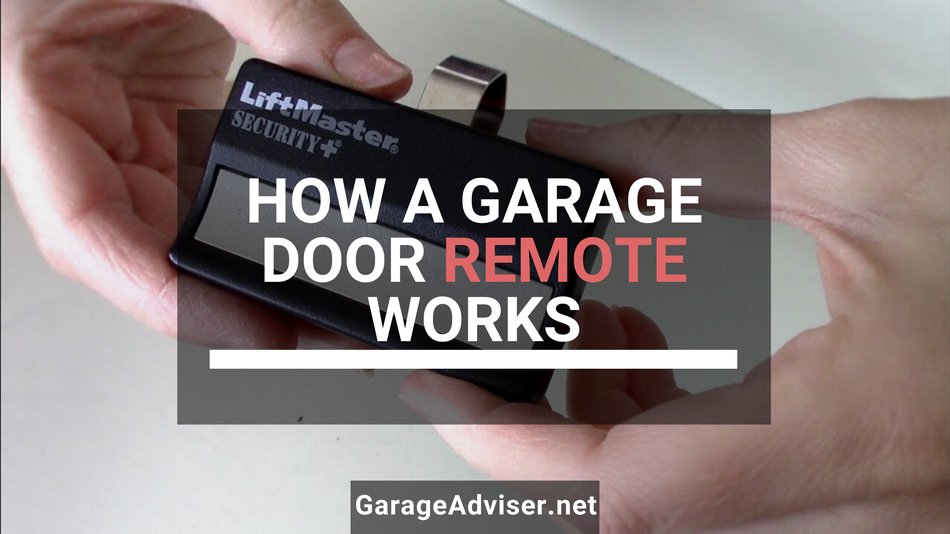
The garage door remote, ever since its invention, has become an essential tool in our lives. We use it every day to get in or out of our homes. Personally never realized how important the remote entry is till the battery died. I had out to get out of my car while it was raining to open my garage door with the keypad. Oh boy, that was such a bad experience.
If you have always wondered how the garage door remote works, then this article is for you. You’ll learn how the garage door remote works with your garage door opener. But first, here is how it works in a few sentences.
When you press the button on the garage door remote, it sends a signal containing a security code through its radio transmitter. The garage door opener’s built-in radio receiver obtains the signal, verifies if the security code is correct, and then operates the motor.
I’ll explain in details how the garage door remote interacts with the opener to open and close, anytime you want it to. Also, we will take a look at how secure it is to use a remote entry for your garage door, and lastly, we’ll discuss some common problems with the remote entry and how to fix them when it happens. Let’s get into it.
How Does a Garage Door Remote Work? – Detailed Explanation
The garage door remote is a radio transmitter. In simple terms, it sends signals through a radio frequency, just like what the broadcasting radio stations do. The only difference is these remotes are not powerful enough to send signals in a long-range.
All garage door opener and remote manufacturers communicate on a frequency band known as the Industrial Scientific Medical band or ISM for short. The ISM frequency band is between 300 MHz and 433 MHz. This is a widely used frequency band, especially in the US, because it doesn’t require any special license to use them.
Garage door remote and opener manufacturers usually go for anything between 300 and 400 MHz, and the most common frequencies used are 300 MHz, 310 MHz, 315 MHz, 318 MHz, and 390 MHz.
Okay, so what happens when the user presses the remote’s button?
A built-in code generator creates a binary security code. After the code is generated, a signal is then sent out with the radio transmitter inside the remote on the manufacturer’s preferred frequency. This signal contains the security code that was generated.
In the process of programming your remote to work with your garage door opener, what happens is the garage door opener learns the frequency of the remote and then “tunes in” on that same frequency, just as you would you tune in on a radio station.
Since both the garage door remote’s radio transmitter and the radio receiver inside the garage door opener is on the same, the signal sent by the remote is received by the garage door opener. The opener processes the signal and acquires the security code, and then the code goes through further verification.
When it passes the verification, the garage door opener will activate either the opening or closing relay, depending on the garage door’s position, and then the motor operates.
How Secure are Garage Door Remotes?
Garage door remotes are now much more secure than ever. Innovation and technology have improved the security of using remote controls to operate the garage door opener. Here is why.
Back when the garage door remote was first introduced, there was a lot of security flaws. Firstly, most manufacturers were using the same frequency for their devices. Also, there was no security code generated. All the remote did was to send a signal to the opener, and it will operate.
This was a major security flaw because anyone with a remote could open any garage door. This was bad because even a neighbour who intends opening his garage door might end up opening other people’s garage.

Manufacturers were made aware of this flaw, and they quickly made some changes and upgraded their devices. The next batch of remotes and garage door openers communicated in 8-bit binary security code, and this solved the problem.
However, the 8-bit binary security code is not secure enough to prevent burglars and hackers whose main intention is to break into your home. Hackers can easily program their devices to send out 8-bit codes to open your garage door. That’s because there are only 256 possible combinations with an 8-bit binary.
To prevent all of the security flaws, manufacturers have now developed much-sophisticated security technology for their remotes, keypads, and openers. This technology is popularly known as the rolling code technology.
Modern remote controllers have a controller chip inside that is capable of generating 40-bit security codes. For every single use of your remote, a new code is generated. Because these chips generate 40-bit codes, there are possibly over a trillion combinations that can be produced. But how does this work?
Built into these chips are random pseudo-code generators that create a new code for every use. Hence the previous code will be nullified. The same type of controller chip is installed inside the garage door opener with the same random pseudo-code generator.
For this reason, both the remote controller and garage door opener generate the same random code at the same time. When the code gets sent from the remote to the garage door opener, it stores it to memory and then compares it to the code inside the opener. The garage door will operate only when these two codes match.
This has made it quite impossible to hack the modern garage door remotes and openers. Unless, of course, you are still using an older device.
Common Garage Door Remote Problems
Sometimes, but not very often, we may experience problems with our garage door remote, not working.
When this occurs, there are a few things you can do to resolve the issue, and we are going to look at them in this section.
Dead batteries
All garage door remotes are battery-powered, and not surprisingly, batteries don’t last a lifetime. There will come a time when you need to replace them. If your garage door opener is not responding to the command from the remote, the chances are that the remote battery has to be replaced.
But before you purchase a new battery, if you own a garage door keypad, try using that to operate your garage door opener to see if it works. If it doesn’t work, the problem might not be with the remote, but if it works, then go ahead and replace the batteries in the remote.
You want to get a battery that will last longer and doesn’t work intermittently. The Duracell CR2032 3V Coin Battery (on Amazon) is a great choice for remote controls, and I recommend you get that.
Remote may need reprogramming.
Some garage door remotes require that you reprogram them anytime you replace a battery. If your remote works with your opener just fine when you swap the batteries, then it might be unnecessary to reprogram. But those that require reprogramming be sure to check your garage door opener’s manual for a step by step guide on how to program remotes.
If you use a Liftmaster opener, I have a guide on how to program remotes, and you can find it here. For Overhead Door garage door opener users, here is how to program your remotes. See here. And if you use a Wayne Dalton here are the steps to follow when programming your remotes. See here.
